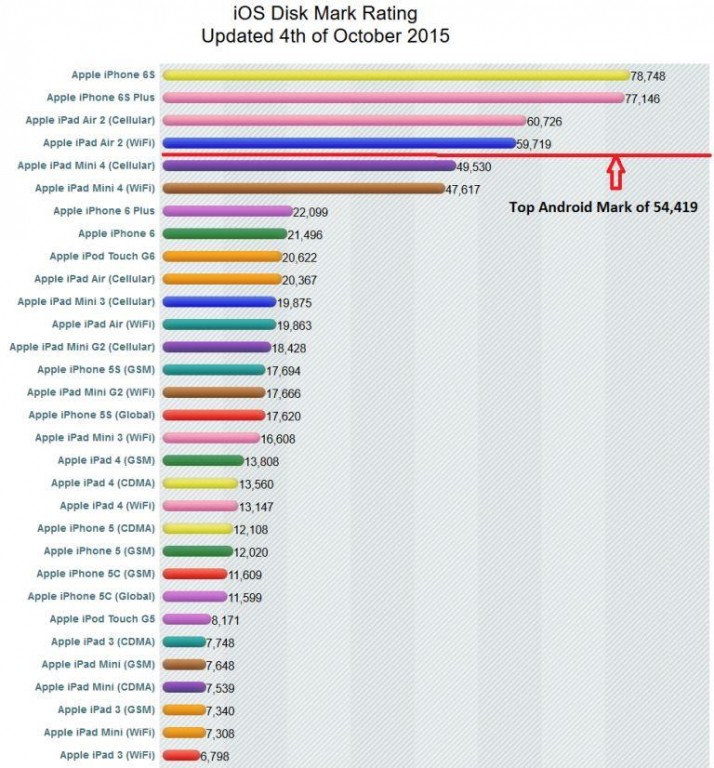Let’s first check out the PassMark iOS Disk Mark ranking of IOS devices and take a look at where the best Android device would fit in with a high point score of 54,419 points:
This chart makes it very easy to see why we might be looking at just the iPhone 6S family.
PERFORMANCE TEST MOBILE
Passmark’s Performance Test Mobile is a free app available for both IOS and Android. Not only does it run a complete set of tests for your smart phone, but it also allows you to upload and join just under 500,ooo other results online. We ran several benchmarks on the same phone, our worst result shown at the beginning of this article while our highest was 1940MB/s read and 390MB/s write…according to their records found here. So we had an idea…
Using this page, one has access to 489967 (time of report) performance results for any phone you can think of…except blackberry that is. We scoured through the last 400 results and decided to eliminate Android and previous iPhones as their performance wasn’t even close. This testing deals only with iPhone 6S and 6S Plus as they’re performance is simply incomparable. We used 3 results for the iPhone 6S Plus 16GB version (all we could find), 10 for the 64GB version (of 22) and 10 for the 128GB version (of 14), comparing each. We had no doubt as to which versions were the most and least popular, however, something else became evident. Check out this chart below.
Forget the high read results right off, but for their positioning. In this chart, we averaged out the results for the 16GB iPhone, 64GB and 128GB iPhone, soon learning that performance, even in a smart phone, seems to coincide with capacity. For those looking for the most bang for the buck, the 128GB capacity seems to be the way to go for both performance and capacity.
FINAL THOUGHTS
The thought that we might ever see transfer speeds of 2GB/s in a smart phone just may be ludicrous. Disk caching may be helping but the ideal of pulling 2GB/s out of a single controller/single memory chip device just isn’t realistic, regardless of how many similar results there may be. While Joshua Ho at Anandtech pegs disk speeds much lower on the same phone, his test results still show the new iPhone 6S as being twice as fast in disk speeds as any Android on the market.
The one thing we can gain from what we have seen here has remained consistent in SSDs for years. Size matters. The bigger your storage the better the performance. Where we see read performance of the 128GB iPhone 6S just over twice as fast as that of the 16GB, write performance is significantly higher.
The thought…2GB/s disk speeds from a smartphone….are we really that far away with NVMe?
Check Out Apple iPhone 6S Pricing at Amazon.![]()
 The SSD Review The Worlds Dedicated SSD Education and Review Resource |
The SSD Review The Worlds Dedicated SSD Education and Review Resource | 


“The implementation of NVMe would be a definite performance booster”
apple must have done a really good job on their controller-seing as Hynix TLC
is probably the cheapest Nand out there.
Les this really cracked me up-
“as would the implementation once again of TLC NAND flash memory to control
the ever escalating cost of the new iPhone.”
Approx cost of $245 that sells for $800
I definitely agree that premium merchandise comes with a premium price; the cost of this phone here after taxes with the protection plan and case would be just under $1800 w/o contract. It still goes to say, however, that their use of a premium Toshiba (or there partner Samsung’s) mlc 128GB chip would have driven the cost up significantly.
Apple also multi-source components. If you look at iFixit iPhone 6s teardown, it’s a Toshiba THGBX5G7D2KLFXG 16 GB 19 nm NAND Flash:
https://www.ifixit.com/Teardown/iPhone+6s+Teardown/48170
Something: why isnt apple putting uSB 3 on these?
1800MB/s? Big B? That doesn’t line up with anandtechs tests (~400-500MB/s iirc) and would make it faster than their Macbook Pros…That seems off. It’s still the fastest phone storage out there but that graph is odd. Even the 16GB is faster than other sites tests of the 64GB.
I don’t think Passmarks scores translate into MB/s, that’s the issue.
*Can’t read the comments.
Which is better as the future of mobile storage, UFS or NVMe?